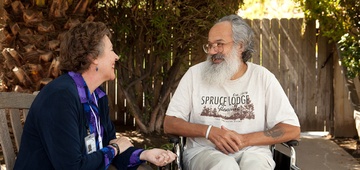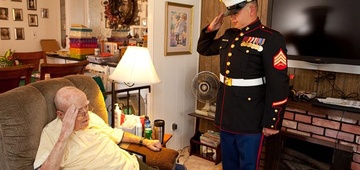Hospice FAQs
Frequently Asked Questions
It is only natural to have questions regarding Hospice and Palliative Care. We've gathered many of the frequently asked questions and answered them here on our website. However, if you have a specific question and do not find answers here, feel free to call us at 858.458.2992 or send us a message using our contact form.
Hospice offers an aggressive and holistic approach to pain and symptom management while also providing spiritual, emotional and psychological support.
What many people don't know is that Hospice is a comprehensive program that provides care and services to both the patients and their loved ones and care givers. Our social workers, volunteers and chaplains help to ease caregiver stress and they provide ongoing bereavement support for a year after the loss of a loved one.
Hospice is about the quality of life and at LightBridge, we have dedicated ourselves to help patients, their families and loved ones embrace each of their individual journeys with a sense of peace and well-being.
Hospice cares for the entire family, not just the terminally ill family member. Hospice focuses on enhancing the quality of life no matter how long that might be. Through services such as symptom relief for the patient and emotional, spiritual and practical support, patients and their families can prepare for death in ways that are meaningful to them. Hospice provides dignity in dying for patients and their loved ones.
No. The goal of Hospice is to help patients live every day to its fullest with the greatest level of physical, emotional and spiritual comfort possible. LightBridge recognizes dying as a natural process. Hospice does not work to hasten death, but enhances the quality of life that remains and provides support to caregivers.
In fact, recent studies have shown that some patients with similar diagnoses who receive hospice care live longer than those who don't.
Hospice is a program that had originally been associated with the terminally ill cancer patient. Current practice makes it available for any terminally ill person in the end stages of cancer, Parkinson's, Alzheimer's, heart disease, or other life limiting diseases or conditions. While the majority of patients are older, the program is available to anyone - regardless of age, sex, religion or disease - who has been diagnosed by a physician as having a life expectancy of six months or less. The care that is provided is not meant to cure the person. It is palliative, which is care aimed at relieving or reducing discomfort.
Hospice is a philosophy of care, not a place. Hospice care can be provided wherever a patient lives including:
- Personal Homes
- Residential Care Facilities
- Assisted Living Facilities
- Long Term Care Facilities
In Hospice, all members of the care team - physicians, nurses, social workers, spiritual care coordinators, hospice aides and volunteers - work together to coordinate and deliver care.
Family Focus:
Hospice care focuses on the entire family. The Hospice team supports the family in caring for their loved one and provides spiritual and psychological support to both the patient and their family members.
Comfort vs. Cure:
For most home health care providers, the goal is to make the patient well. With Hospice care, the staff and family recognize that the patient will not get well if the disease process follows its normal course. The focus is on comfort and support rather than cure.
Grief Support:
Hospice care does not end when a patient dies. Hospice staff maintain contact with the family for one year after the death of a patient to help them deal with their loss.
The LightBridge team assesses and treats not only the patient's physical pain but they also address the emotional and spiritual pain of the patient, family and caregivers.
The goal of our pain management program is to continually maintain a balance between the alleviation of pain and a patient's functional level so that the patient can continue to optimally interact with loved ones. Hospice nurses and doctors are specially trained in the use of a variety of pain medications and other techniques, including integrative therapies for pain and symptom relief.
Spiritual and psychological pain is experienced by both patients and loved ones. This is addressed by the entire team, with particular emphasis on the assessment and support provided by our spiritual care coordinators and social workers.
The patient's physician may remain responsible for their care and work in collaboration with the LightBridge nurses and team members serving the patient. In addition, the Hospice Medical Director is always available for consultation on pain management or other specific care issues.
Anyone can refer a patient to LightBridge. Many referrals originate with the patient's physician or with the staff of the facility where the patient lives. Others come from hospital discharge planners, social workers or patient's families. To be admitted, a patient must agree to treatment aimed at comfort rather than cure and have an advancing disease process which results in a limited life expectancy as certified by his or her physician and the Hospice physician.
At any time during a life limiting illness it is important to consider all care options, including Hospice. Hospice becomes an appropriate choice when curative treatments are no longer effective and the patient and physician believe that comfort care is the right choice.
It is helpful to remember that Hospice professionals agree they can be more effective when given optimal time to guide patients and their families through the challenging maze of concerns. The sooner the Hospice team is in place, the more time patients and families are afforded to focus on the quality of their relationships and living life to its fullest.
With the increased care and support provided by the Hospice team, a patient's condition may significantly improve. If the patient's condition improves and stabilizes they may be discharged from Hospice. If the patient should need to return to Hospice care at some point in the future, LightBridge can assist with readmission.
Hospice care is covered by Medicare, Medi-Cal and most private insurance companies. LightBridge can assist you in determining what specific benefits are available from your insurance carrier or HMO.
No. The Hospice team provides continuing support and bereavement services to families for the year following their loved ones' death.
The End of Life Option Act is a California law that allows terminally ill adults with capacity to make decisions to be prescribed an aid-in-dying medication if certain conditions are met. California was the fifth state to enact an aid-in-dying law when it went into effect June 9, 2016. In October 2021, Governor Newsom signed SB380, which made significant changes to the law. To read more about California's End of Life Option Act, visit Coalition for Compassionate Care of California. It is the mission of LightBridge Hospice & Palliative Care to meet the needs of patients in a way that honors how they wish to live their final months or days. LightBridge acknowledges there may be hospice patients who wish to avail themselves of their legal right to pursue medical aid-in-dying as their end-of-life option of choice. LightBridge will not abandon these patients or their families for this decision and is ready to discuss and support end-of-life decisions while being sensitive to individual values and/or belief systems.



